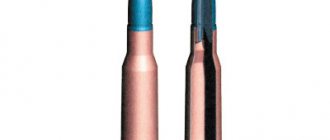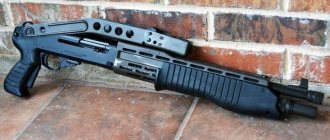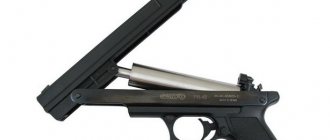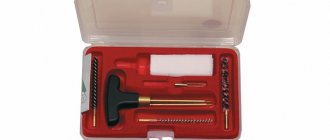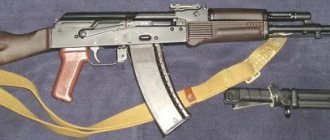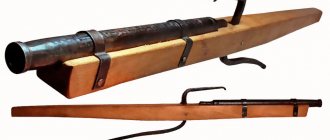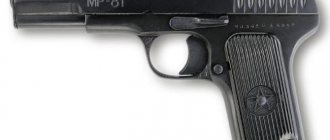Foreign machine guns and assault rifles
SIG SG 550 assault rifle
SIG SG 550 assault rifle.
Heckler & Koch G36 assault rifle
Heckler & Koch G36 assault rifle.
Having adopted the G3 into service in 1958, Germany did not switch to the smaller 5.56 mm caliber ammunition for a long time. Reconfiguring the G3 rifle for the new cartridge did not cause any problems. This was done already in 1968, when the NK 33 model appeared, which was an analogue of the G3, converted from a caliber of 7.62 to 5.56 mm.
FAMAS F3 assault rifle
FAMAS F3 assault rifle.
For several post-war decades, the French army was armed with MAS 49/56 self-loading rifles chambered in a unique 7.5 mm caliber cartridge, which was not used in any NATO country, although the French MAT 49 submachine guns had the standard NATO caliber - 9 mm.
Valmet/Sako assault rifle
Valmet/Sako assault rifle.
After the end of hostilities, Finland, which had a hard time surviving World War II, did not dare to join NATO, fearing the reaction of the powerful USSR. Relying solely on their own forces, the military command introduced universal conscription and a reservist system, which made it possible to quickly deploy a peacetime army into thousands of self-defense troops.
FN SCAR assault rifle
FN SCAR assault rifle.
In 1987, a new structure was formed within the US armed forces - US SOCOM (US Special Operations Command). It united special units of the Army, National Guard, Air Force, Navy and Marine Corps.
M4 and Colt Commando assault rifle
M4 and Colt Commando assault rifle.
Colt, a manufacturer of M16 A2 rifles, established in the 1980s. release of a whole family of assault rifles of the 700 series. Most likely, the number 7 in the designation is the number of types of rifles that Colt produced in different years.
M16 assault rifle
M16 assault rifle.
In 1963, a new weapon was adopted into service in the United States to replace the 7.62 mm M14 rifle. This was an epochal event in the history of wars. For the first time, a rifle with a reduced caliber of 5.56 mm was put into service. It had the designation M16 A1.
Beretta AR70 and AR70/90 assault rifles
Beretta AR70 and AR70/90 assault rifles.
The first standard rifle of the army of post-war Italy was the American M1 Garand self-loading rifle. The famous company Pietro Beretta was involved in the licensed production of this weapon. In 1959, the new model Beretta BM 59 was adopted by the Italian army.
CETME assault rifles
CETME assault rifles.
Immediately after the end of the Second World War, the state enterprise CETME was created in Madrid - Centra de Estudios Tecnicos de Materiales Especiales ("Center for Research of Special Technical Materials"), which was engaged in the production of ammunition, gunpowder and explosives.
TAR 21 assault rifle
TAR 21 assault rifle.
For several decades, the Israel Defense Forces (IDF) have had a number of assault rifles of various designs and different manufacturers in service. These are the American M16 and M4, produced both in the USA and in Israel under license, the American CAR 15 rifles from Armalite, as well as modifications of the Israeli Galil rifle.
Galil assault rifle
Galil assault rifle.
Specialists from the Israeli company IMI (Israel Military Industries) have never denied that the prototype of this weapon was the Soviet Kalashnikov assault rifle. From the beginning of its existence, Israel was surrounded by the armies of the Arab League, which were armed with Soviet AK-47 assault rifles.
L85 assault rifle
L85 assault rifle.
The history of the development of this weapon is perhaps the longest in modern practice. Back in the early 1950s. British designer Noel Kent-Lemon presented a completely non-standard EM2 rifle to the British military.
FN F2000 assault rifle
FN F2000 assault rifle.
In the mid-1990s. Leading design bureaus of Western countries were developing a new universal type of small arms to arm soldiers of the 21st century. The customer was the joint command of NATO countries.
FN FAL and FNC assault rifles
FN FAL and FNC assault rifles.
Europe was just beginning to recover from the wounds inflicted by the Second World War, and work was already in full swing in the design bureau of the famous Belgian arms manufacturer, Fabrique Nationale. A group of engineers led by Dieudonne Seve began developing an automatic assault rifle.
Steyr AUG 77 assault rifle
Steyr AUG 77 assault rifle.
After World War II, Austria became one of the founding countries of the NATO bloc. In 1958, the Austrian army adopted the M58 assault rifle, which was a modification of the FN FAL rifle from the Belgian concern Fabrique Nationale.
Silent Soviet special forces
Imagine a silent pistol. On the bipod. Shooting a high explosive or incendiary grenade. Scary? But what can you do - a Soviet special forces soldier must steadfastly overcome hardships.
"Product D"
For what? To quietly sneak up to a NATO airfield, radar, launcher or some other valuable property - and shoot. The explosion, of course, will be heard - but it will be more difficult to find the shooter himself.
The military liked “Izdeliye D”; the idea was developed into “Izdeliye DM” - with a folding stock instead of a holster-butt. And then the silent grenade launcher was attached to the AKM, receiving “Silence”. Then they switched to the shortened AKS-74U, assigning the name “Canary” to the product.
“Silence” (photo: Kalashnikov Media)
Recently we also invented a silent mortar. 2B25 "Gall" fits in a backpack, weighs only 13 kilos - but can cause a lot of trouble. The only way to find his position is with a counter-battery radar.
2B25 "Gall" (photo: UVZ)
What about our friends overseas?
Russian special forces weapons
Army weapons
Army weapons.
One of the most common types of weapons is military-style weapons. On its basis, hunting versions and self-defense weapons are created, and most often they end up in private hands in their original form.
Army Weapon Review
Review of army weapons.
It is no secret that the basis for such developments was the Czechoslovak Scorpion submachine gun. This sample belongs to the so-called small submachine guns, which are almost no different in size and weight from automatic pistols.
Automatic grenade launcher complex OTs-14 "Groza"
The OTs-14 “Groza” automatic grenade launcher system was developed in the early 1990s.
for arming special police forces operating in dense urban areas. At the same time, the designers sought to create a weapon that would ensure reliable destruction of openly positioned manpower, including personal armor protection, light armored vehicles and vehicles, and at the same time give a minimum number of ricochets. We also took into account the fact that installing an under-barrel grenade launcher, necessary for solving these problems, on a weapon of a classical layout design significantly worsens the balance of this weapon. In addition, to facilitate the introduction of the new complex into mass production, it was decided to unify it to the maximum extent with the serial 5.45-mm Kalashnikov AKS-74U assault rifle. A prototype of the complex was demonstrated in 1994. It included an assault rifle, a VII-25 under-barrel grenade launcher, and special SP cartridges. 5 and SP. 6, fragmentation rounds VOG-25 and VOG-25 P.
The machine gun is designed according to the bullpup layout with the automatic mechanisms and magazine placed behind the fire control handle. This made it possible to significantly reduce the length of the weapon, reduce its “bounce” under the influence of recoil force, and, in the presence of an under-barrel grenade launcher, to ensure balance with the location of the weapon’s center of gravity in the area of the fire control handle.
Silent small arms grenade launcher systems "Silence" and "Canary"
In the 1970s, the silent rifle-grenade launcher system “Silence”, developed by the designers of the TsNIITOCHMASH enterprise, began to enter service with special forces brigades of the Soviet Army and special forces units of the border troops of the KGB of the USSR.
The creation of the complex was due to the fact that for solving a number of special tasks (destructing missiles on the march and launch positions, defeating light armored vehicles, helicopters and airplanes on the ground, etc.) the effectiveness of special silent small arms was insufficient. The “Silence” complex includes: a special silent modification of the 7.62-mm Kalashnikov assault rifle with a folding shoulder rest AKSMB with a silent and flameless firing device PBS-1; 30-mm special silent under-barrel grenade launcher BS-1; a special combat cartridge 7.62 x 39 mm US (reduced velocity) with a subsonic initial velocity of a weighted bullet and a throwing cartridge based on the standard 7.62 x 39 mm cartridge.
A special feature of the complex is that it combines not only two types of projectiles (bullet and grenade), but also two basic principles of reducing the sound level of a shot - expansion of powder gases in a variable-closed volume (gas cut-off) and preliminary expansion and cooling of powder gases before releasing them into the atmosphere.
Sniper rifle SV-99
The SV-99 rifle was developed by designers of the Izhevsk Machine-Building Plant. It is intended primarily to arm fighters of assault groups of special forces of the police, FSB and internal troops of the Ministry of Internal Affairs of the Russian Federation, conducting combat operations in dense urban areas. It can also be used as an individual weapon of the second number in a large-caliber sniper rifle.
This purpose of the rifle determined the choice of ammunition for it - a 5.6 mm rimfire cartridge (.22LR). Although the effective fire range of this cartridge does not exceed 100 m, and the destructive effect of the bullet is relatively small, the cartridge is excellent for creating both high-precision short-range weapons and silent and flameless shooting weapons. When creating the SV-99, the designers used individual technical solutions previously implemented in the biathlon rifle BI-7 -2 (“Biathlon-7 - 2”) and the hunting carbine “Sobol” produced by the Izhevsk Machine-Building Plant.
Special sniper rifle VSS “Vintorez”
Special units of the KGB of the USSR and reconnaissance and sabotage units of the Soviet Army in 1987 received a very effective silent sniper complex (VSK), developed by the designers of the TsNIITOCHMASH enterprise P. I. Serdyukov and V. F. Krasnikov in accordance with the tactical and technical requirements approved GRAU at the end of 1985.
The complex includes a special sniper rifle VSS “Vintorez” (GRAU index 6 P29), a 9-mm special cartridge SP. 5 (index GRAU 7 N8), optical or night sight and accessories.
The sniper rifle is the main component of the complex. It is designed according to a classic layout scheme and is equipped with automatic reloading mechanisms that operate using the energy of powder gases discharged through a hole in the barrel into a gas chamber located above the barrel in a plastic fore-end. The barrel bore is locked by turning the bolt, which has six lugs.
The striker-type impact mechanism ensures firing in single shots and bursts. The fire mode selector is located inside the trigger guard behind the trigger. When the translator lever is moved to the right, a single fire is fired (there is one white dot on the right side of the receiver behind the trigger box); when the lever is moved to the left, there is a continuous fire (there are three white dots on the left side of the receiver).
Rifle sniper complex VSK-94
The VSK-94 silent rifle sniper complex was developed by the Tula enterprise KPB in 1995. It is intended to arm special police forces and internal troops of the Ministry of Internal Affairs of the Russian Federation, as well as reconnaissance groups of army special forces. The complex can be used as an individual weapon of the second number in a long-range sniper rifle, while the ability to fire silently in automatic mode significantly increases the capabilities of a sniper pair.
The complex includes the VSK-94 sniper rifle itself and special 9 x 39 mm SP cartridges. 5, SP. 6 or PAB-9, optical sights PSK-07 (day) and PKN-03 M (night), as well as a container case for carrying the complex.
The rifle was developed on the basis of the 9-mm assault rifle 9 A-91. It has the same automatic reloading mechanisms, which operate by using the energy of powder gases removed from the barrel when fired.
Automatic 9 A-91
To arm soldiers of special police units and special forces units of the internal troops of the Ministry of Internal Affairs of the KPB in the early 1990s.
developed a small-sized assault rifle 9 A-91. The assault rifle was adopted by the internal troops of the Ministry of Internal Affairs of the Russian Federation in 1994. The command of the Russian Army also showed a certain interest in the assault rifle, since it can be armed with military personnel who are not directly involved in hostilities: drivers of transport vehicles, radio station and radar operators, etc. . The machine gun is designed according to a classic layout using automatic reloading mechanisms operating according to a well-developed scheme using the energy of powder gases removed from the barrel bore. Automation gas engine with a long stroke of the gas piston; to give the rod the required length, the gas chamber is extended forward. The barrel bore is locked by turning the bolt, which is equipped with four lugs.
The reloading handle located on the right side is rigidly connected to the bolt frame.
The hammer-type trigger mechanism allows firing single shots and bursts.
Automatic OTs-11 "Tiss"
Due to the aggravation of the criminal situation in the Russian Federation in the early 1990s. under the auspices of the Main Directorate for Combating Organized Crime of the Ministry of Internal Affairs of the Russian Federation, special rapid response departments (detachments) were created in the republics, territories and regions. There was a strengthening of special purpose police units (OMON), created back in Soviet times, as well as special purpose units, operational brigades and divisions of internal troops. The units of these formations were armed with army small arms, which were unsuitable for combat operations in dense urban areas. Bullets from live 5.45- and 7.62-mm cartridges gave a lot of ricochets and created a danger for passers-by who accidentally found themselves in the special operations zone. At the same time, the stopping effect of these bullets was not enough.
A weapon specially created for use in police special operations was the small-sized OTs-11 “Tiss” assault rifle. It was created in the early 1990s, and in 1993 the first batch of assault rifles of this type entered service with the special forces of the Ministry of Internal Affairs of the Russian Federation.
In order to speed up the development and organization of mass production of new weapons, a standard AKS-74U assault rifle was used as a prototype, which was modified for new ammunition - SP cartridges. 5 and SP. 6.
Special automatic machine AS "Val"
Since the late 1980s.
The AS “Val” special assault rifle (GRAU index 6P30) also entered service with special forces units of the KGB and the Soviet Army. Currently, the AS "Val" is part of the armament of special forces units of many law enforcement agencies of the Russian Federation. The machine was developed by a group of designers from the TsNIITOCHMASH enterprise headed by P. I. Serdyukov. It is part of a silent machine gun complex, which also includes a special machine gun cartridge SP. 6 and affiliation. The complex is designed to defeat the enemy during special operations in conditions requiring silent and flameless shooting.
When developing the AS “Val”, the VSS “Vintorez” rifle was used as a base; more than 70% of the parts and assemblies of these weapons were unified. Like a rifle, the machine gun has automatic reloading mechanisms that operate by using the energy of powder gases discharged through a side hole in the barrel. The barrel bore is locked using a rotating bolt, which has 6 lugs, using cutouts in the receiver. The rate of fire is 800 - 900 rounds/min, combat rate of fire is 40 - 60 rounds/min.
Underwater special assault rifle APS
Like the SPP-1 special underwater pistol, the APS special underwater assault rifle is designed to arm scuba divers of the naval special forces of the Navy. Research aimed at creating underwater small arms has been carried out in the USSR since the late 1950s.
In the 1960s they were activated, as underwater saboteur units were created in the fleets of a number of NATO countries.
The result of many years of research and development work was a unique, still unparalleled in the world, APS automatic machine (“underwater special automatic machine”), developed by the TsNIITOCHMASH enterprise. Its first versions were designed by P. A. Tkanev, an employee of this enterprise; subsequently, V. V. Simonov was the leading designer. The assault rifle was adopted by the naval special forces of the USSR Navy in 1975. Its production was organized at the Tula Arms Plant.
Although the APS assault rifle is designed for firing underwater, its design, in principle, differs little from conventional land-based models of automatic small arms. It has automatic reloading mechanisms, the operation of which is based on the use of the energy of powder gases removed from the bore of a smooth barrel when fired.
Automatic SR3 "Whirlwind"
Currently, the 9-mm small-sized SR assault rifle is currently being mass-produced and entering service with special forces units of various law enforcement agencies of the Russian Federation. Z. The machine was developed by the designers of the TsNIITOCHMASH enterprise A.D. Borisov and V.N. Levchenko. At the development stage, it was designated MA - a small-sized assault rifle; it was adopted into service in 1996 under the designation SR. Z (SR - special development).
Relatively small size and weight of the SR. These make it one of the most compact and convenient small arms for special operations, ensuring the destruction of protected targets at a range of up to 200 m. SR. The Z is designed on the basis of the 9-mm AS Val silent assault rifle, which, in turn, is a variant of the VSS Vintorez sniper rifle.
The main difference between SR. The main benefit of the prototype is the absence of a shot silencer, which made it possible to design the weapon as compact and suitable for concealed carry.
Submachine gun PP-93
Disadvantages of the PP-90 that reduce the effectiveness of its use by special forces units. These shortcomings include, first of all, the relatively long time it takes to bring the PP-90 into combat position, as a result of which special forces soldiers did not always have time to respond in time with fire to a sudden enemy attack.
The insufficient length of the stock and unsatisfactory ergonomics also cause criticism.
Due to the fact that many of the shortcomings of the PP-90 were due to the need to ensure its folding when transferred to the stowed position, it was decided to develop a new submachine gun based on the PP-90, the compactness of which in the stowed position is ensured by the metal butt folding forward and upward. great length.
The Tula enterprise KBP presented a prototype of a new submachine gun under the designation PP-93 for testing in 1993. It is intended for arming special police forces and internal troops of the Ministry of Internal Affairs of the Russian Federation. The PP-93 can be used by crews of armored vehicles and helicopters; due to its compactness, the submachine gun is used for concealed carry by law enforcement officers.
PP-90 submachine gun
After what happened in the West in the late 1970s. kidnappings and murders of famous politicians and businessmen, the American Eugene Stoner (E. Stoner) developed a folding submachine gun FMG (Folding Submachine gun) for the security services, produced by Ares in a small series. In the stowed position, it looked like an inconspicuous metal box the size of a portable radio, which within a few seconds turned into a formidable weapon capable of repelling an attack by armed terrorists.
The USSR became interested in a folding submachine gun. At the end of the 1980s. The Tula enterprise KBP was tasked with developing a similar weapon. A prototype of the Soviet folding submachine gun PP-90 was ready in 1991. After short tests, it was adopted by army and police special forces, and it also entered the units of the Main Directorate of Security and the Federal Security Service of the Russian Federation. The PP-90 is close in design to the IMS submachine gun.
Shooting knife OTs-54 “Kit”
A very effective example of a personal weapon for fighters in special forces units is the OTs-54 “Komplekt” system.
The system includes a shooting knife, a saw with large teeth, an ax, as well as a carrying bag with compartments for an awl and other accessories necessary for long-term operations behind enemy lines.
The shooting knife is the main element of the OTs-54 system. It consists of a handle and a blade. The trigger mechanism of the firing device is mounted in the handle, made of electrically insulating material, and a blade is attached, approximately equal in length to the bayonet-knife of an AKM assault rifle. The firing device is designed in such a way that its 9-mm barrel chambered for the PM cartridge can be replaced with a barrel chambered for a different caliber. Options for a shooting knife chambered for 7.62 x 42 mm SP cartridges have been developed. 2 or SP. 3,5,45 x 18 mm MCP and 9 x 18 mm PM.
Scout shooting knife NRS/NRS-2
Shooting knives were personal weapons of attack and defense for military personnel of special reconnaissance units of the Soviet Army and the KGB of the USSR. They are also used by Russian special forces units. Knives are designed to defeat an enemy in close combat with a blade, when striking or throwing, as well as with a shot without noise and flame at a distance of up to 25 m.
The first example of a shooting knife was the NRS (scout shooting knife), developed in the 1970s. under the leadership of R. D. Khlynin. The knife was assigned the index GRAU 6 P25.
The NRS was created on the basis of a conventional HP reconnaissance knife chambered for a 7.62 mm special SP cartridge. 3, ensuring silent and flameless shooting. It differs from the basic sample in that a disposable firing device is mounted in the rear part of the handle, consisting of a detachable barrel with a locking device and two locking protrusions made on the barrel, a trigger mechanism, a cocking lever, a safety lever and a release lever.
Underwater pistol SPP-1
Work on the creation of an underwater pistol for arming scuba divers of the naval special forces of the Navy began in the USSR in 1966. They ended in 1970 with the adoption by the Navy of an original pistol complex developed by the designers of the TsNIITOCHMASH enterprise O. P. Kravchenko and P. F. Sazonov . The complex consists of a 4.5 mm special underwater pistol (SPP-1) and an underwater pistol cartridge 4.5 x 39Ya SPS (with a steel bullet). The complex also includes ten cartridge clips, a holster made of artificial leather, a device for loading clips, a waist belt for carrying and three metal cases for loaded clips. The production of the complex was established at the Tula Arms Complex and is an underwater SPS cartridge with a needle-shaped bullet of high elongation inserted into a special sleeve with a blunt head. The action of the cartridge is based on the use of a physical phenomenon - cavitation (from the Latin savitas - “cavity”, “emptiness”).
PSS "Vul" pistol
In 1983, a unique pistol complex, intended for use as a personal weapon for covert attack and defense, entered service with special forces units of law enforcement ministries and departments of the USSR. Silent shooting and no flash when fired make this complex an almost ideal weapon for special operations. The complex was designed in the early 1980s. designers of the TsNIITOCHMASH enterprise Yu. M. Krylov and V. N. Levchenko. It includes a “7.62-mm self-loading special pistol PSS” (GRAU b P24 index), a special pistol cartridge SP. 4 and a holster.
The most interesting element of the complex, which ensures silent and flameless firing from a pistol, is the special SP cartridge. 4, which uses a very effective scheme for reducing the sound level of a shot - “cutting off” the powder gases.
Pistol SME "Groza"
In the 1960-1970s. In the USSR, various types of silent small arms were developed for the so-called cartridge with cut-off of powder gases. This weapon belongs to systems with the expansion of powder gases in a variable-closed volume and is intended to hit targets in special operations that require silent and flameless shooting.
One of the first types of weapons chambered for a cartridge with a cut-off of powder gases was created by the designers of the Tula Arms Plant in the late 1960s. It was a pistol with the factory designation T03-37 M. It was adopted into service by the Soviet Army and the KGB of the USSR in 1972 under the designation “7.62 mm small-sized special pistol (SME).” It was also given the name "Thunderstorm".
Pistol PB
The PB pistol (“silent pistol”, index GRAU 6 P9) was developed by the designer of the TsNIITOCHMASH enterprise A. A. Deryagin. It was adopted by the Soviet Army in 1967. The main purpose of the pistol is to silently defeat the enemy at short distances.
The PB was developed on the basis of the Makarovn PM pistol and is distinguished, first of all, by a modified design of the barrel and bolt, integrated with a silencer. The muffler consists of a casing with an expansion chamber placed on the barrel and a nozzle with a separator screwed to the front of the casing. When fired, the powder gases following the bullet enter the expansion chamber, where they lose energy and speed. For the same purpose, a nozzle with a separator is used, in which powder gases swirl in counter-flows. As a result, powder gases flow out of the hole in the front of the muffler at subsonic speed, without producing the sound of a shot. At the same time, complete muffling of all sound sources is not ensured; the sound is sharp
Blasters of World War II
There's almost nothing weird about the M3 carbine with night sights...except for the looks! A real weapon from the end of World War II looks like a fantastic blaster from a cheap 80s action movie. The Japanese in Okinawa managed to appreciate the new product - their favorite tactic of “sneaking up at night” stopped working completely.
The Third Reich, meanwhile, came up with the legendary “Panzerknakke” (more precisely, Panzerknacker) - a 30-mm grenade launcher hidden in the sleeve. This wunderwaffe was immortalized by the novel “The Moment of Truth” by Vladimir Bogomolov.
It is often thought that “panzerknakke” was invented by evil security officers. However, the grenade launcher was quite real - it was even tested in 1944 at a Soviet training ground. Since no one wanted to risk their hand, the trophy thing was secured to a wooden model of the hand with a steel “angle”. The recoil of the shot threw the grenade launcher along with the “arm” tens of meters - until it was crushed by a 35-kilogram plate! Moreover, out of four grenades, two simply did not explode.
"Panzerknakke"
Later, Soviet technicians gave a worthy response to the Germans.
